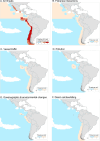Integrating cultural dimensions in sperm whale (Physeter macrocephalus) conservation: threats, challenges and solutions
- PMID: 40308138
- PMCID: PMC12044368
- DOI: 10.1098/rstb.2024.0142
Integrating cultural dimensions in sperm whale (Physeter macrocephalus) conservation: threats, challenges and solutions
Abstract
Culture-socially transmitted behaviours shared within a community-can influence animal populations' structure, vulnerability and resilience. Clans of sperm whales in the Eastern Tropical Pacific (ETP) exemplify the profound influence of culture on these dynamics and highlight the challenges of accounting for culture in conservation efforts. Globally, sperm whales are classified as vulnerable, and the ETP sperm whale population has struggled to reach a positive growth rate. This stagnation is partly due to cumulative anthropogenic threats in the region, including fishing conflicts, vessel traffic, pollution, deep sea mining, oil and gas exploration, and anthropogenic climate change. The United Nations Convention on Migratory Species adopted a Concerted Action for ETP sperm whales in 2017, proposing collaborative efforts to address cultural dimensions in conservation. However, knowledge gaps and real-world implementation challenges persist. Here, we review the role of social transmission in shaping sperm whale behaviour and populations, outline current anthropogenic threats and environmental stressors they face in the ETP, and discuss the ongoing challenges of incorporating cultural dimensions into large-scale international conservation efforts. Strengthening transnational collaboration and capitalizing on new technologies for efficient analysis can help bridge these knowledge gaps and enhance future research on this iconic species.This article is part of the theme issue 'Animal culture: conservation in a changing world'.
Keywords: Eastern Tropical Pacific; anthropogenic threats; behaviour; conservation; social transmission; sperm whale clans.
Conflict of interest statement
We declare we have no competing interests.
Figures



References
-
- Keith SA, Bull JW. 2017. Animal culture impacts species’ capacity to realise climate‐driven range shifts. Ecography 40, 296–304. (10.1111/ecog.02481) - DOI
-
- Whitehead H, Rendell L, Osborne RW, Würsig B. 2004. Culture and conservation of non-humans with reference to whales and dolphins: review and new directions. Biol. Conserv. 120, 431–441. (10.1016/j.biocon.2004.03.017) - DOI
Publication types
MeSH terms
Grants and funding
LinkOut - more resources
Full Text Sources

